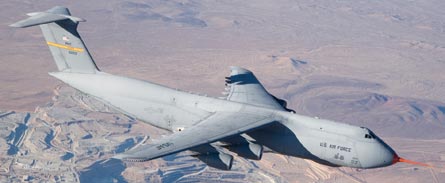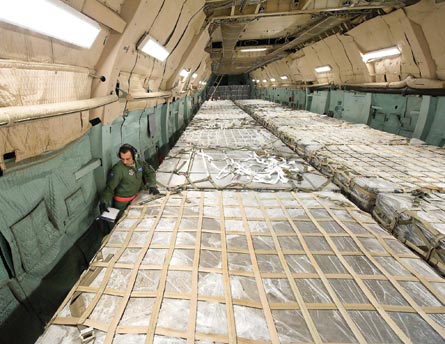An unfortunate flock of four storks with roughly 1.9m (6ft) wingspans crossed into the path of a Lockheed Martin C-5 on take-off from Incirlik air base in Turkey earlier this year. For the four-engined C-5, sucking even four large fowls into a single engine is normally an unremarkable event, as its three remaining turbofans provide easily enough power to bring the aircraft back to base.
But this incident proved unusual for what did not happen, inadvertently revealing the product of an $11.7 billion investment to dramatically improve Lockheed's giant airlifter.
|
|---|
VIBRATION
As the storks sucked into the engine nacelle, the flightcrew noticed a "slight vibration". The engine's throttle was quickly pulled back to idle, but the crew expected a flameout. The engine, although damaged, never shut down.
"It was still producing thrust the whole time," marvels Capt Cory Damon, a C-5 evaluator pilot at Dover AFB, Delaware.
Such experiences may be relatively common among users of modern, large turbofan engines, but not in the US Air Force's C-5 Galaxy community until last year.
Twelve months ago, the USAF started flying the first of three re-engined and upgraded C-5Ms on operational missions.
The bird strike at Incirlik happened to involve one of those three C-5Ms, each now powered by four General Electric CF6-80C2s, which are at least a full generation of technology beyond the legacy C-5 fleet's GE TF39s.
"We've always had an airframe that was so much more capable, but we were limited by the engines," says Lt Col Michael Semo, chief of the C-5M integration office at Dover. "Now we have an engine that matches the capability of the airframe."
Since its debut, the new fleet of pre-production C-5M models has quickly made a favourable impression among pilots and maintenance crews, even as it has added a new layer of complexity to the USAF's calculations for determining the appropriate size and mix of strategic airlifters in the future.
|
|---|
Some new aircraft designs wait years to begin operations in combat zones despite being declared ready for service. The C-5M has received no such luxury. Within its first year of operations, the C-5M has completed a single sortie that broke 41 aviation records and participated in two real-world surges of equipment and troops into Afghanistan, with the latest airlift spike ending a month ago.
It is an airlifter that first started flying 41 years ago, but is now enjoying a second wind. The oldest version in the fleet is the C-5A model, and the 59 left in service are unavailable for missions due to maintenance and repairs more often than they are not. The 49 C-5Bs - manufactured about 25 years ago - are more reliable, but are out of commission on average by 35%.
The key factor driving the C-5's poor reliability record is the TF39 engine, a first-generation turbofan that represented a major leap in propulsion technology during the late 1960s, but falls well below modern standards. USAF officials have complained each TF39 must be removed from the wing for overhaul every 1,000h. The reliability of modern turbofans is at least an order of magnitude greater.
During the most recent, month-long surge, when two C-5Ms flew a combined 22 missions from Rota, Spain to three locations in Afghanistan, delivering about half the equipment for a newly inserted combat brigade, the improved reliability showed. Only one of the C-5M's 22 missions left Rota behind schedule due to a maintenance problem, Semo says.
The same surge also involved a combination of eight C-5A/Bs. Despite outnumbering C-5Ms by four times on the ramp at Rota, the C-5A/Bs delivered less cargo despite flying one more flight than the upgraded C-5M. Most tellingly, USAF mobility planners felt obliged to assign eight C-5A/Bs to complete a mission that could be performed by two C-5Ms.
Such performance may redefine how the C-5 fleet should be perceived. The C-5 is by far the USAF's largest airlifter, capable of carrying 50t more payload than the Boeing C-17. The C-5 is also the only aircraft that can carry the army's 74t mobile scissors bridge. But the fleet has been plagued by reliability problems since entering service in 1969. So far, the C-5M has shown greater payload performance with a fraction of the maintenance burden.
The M-model "really makes the C-5 what it was envisioned to be when it was designed", says Capt Matt Jaeger, chief of pilot standards evaluation at Dover AFB.
Replacing the troublesome TF39 provided the greatest improvement, but the C-5M programme funded 70 other reliability enhancements. Most of the list of upgrades are not visible to anybody but the maintainers.
|
|---|
HEALTH DIAGNOSTICS
A key example cited by Semo is an improved health diagnostic system, which is enabled by the even more significant upgrade to transition the C-5's electrical systems from analogue to digital format.
For the C-5A/Bs, a problem as simple as fixing a wheel brake could ground the aircraft for several hours, as maintainers sometimes needed to pull all 24 brake hubs to find the pair that was broken. It is a relatively simple repair job, but often the "crew would have to go into crew rest" before it was complete, Semo says, which led to even longer delays.
The C-5M's digitally based diagnostic system tells the maintainers exactly where to find the faulty brakes. "With the B-model that would take at least six hours," Damon says. "But with the -M , it's the first place you look."
Perhaps the most visible change among the C-5M upgrades is a new fluorescent lighting system in the cargo compartment. "The 'B' could be a little bit of a hazard with the amount of light in the cargo compartment," Jaeger says.
The next stage for the C-5M programme is ramping up production to convert the rest of the 49 C-5Bs. The first production version of the C-5M is scheduled for delivery before 1 October.
EXCESS CAPACITY
Meanwhile, the USAF is struggling to balance what it considers an excess of capacity in its strategic airlifter fleet.
The USAF acquired the Boeing C-17 to replace a fleet of 270 Lockheed C-141 Starlifters. Including 43 C-17s added by Congress since 2007, the USAF's C-17 fleet will add up to 222, with one aircraft lost to a crash in early August. Although the C-17 fleet is smaller, the Boeing airlifter can carry more than twice the cargo of the C-141.
In addition, the USAF also continues to lease the Antonov An-124, which can haul eight mine-resistant ambush protection vehicles compared with only five inside the C-5.
According to USAF statistics, the combination of 111 C-5s and 222 C-17s provides a capability to move nearly 36 million ton miles per day, but the service needs capacity to transport a maximum of 32.7 million ton miles daily.
To rebalance the fleet, the USAF has asked Congress to repeal a law banning the service from retiring any C-5As. Specifically, the USAF wants to retire 17 C-5As next year and five more in fiscal year 2012, slashing the A-model fleet by more than one-third. So far, lawmakers have been reluctant to allow any C-5A retirements, as certain bases, such as Westover AFB in Massachusetts, now depend on the aircraft's presence to justify their existence.
The C-5M's improved performance may complicate this debate by adding a new dimension. In 2007, the USAF decided to remove the C-5A fleet from the re-engining and reliability enhancement programme (RERP) after Lockheed's cost projections had grown by 58%.
The cost overrun followed a similar budget fiasco for the C-5 avionics modernisation programme, which is required for the Galaxy fleet to continue to operate in controlled airspace and as a precursor to the RERP upgrades.
|
|---|
Source: Flight International



























